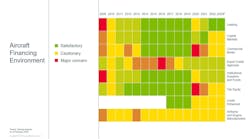Communication is an issue that’s fast becoming a significant safety problem. Communication, that is, between you the mechanic and the Federal Aviation Administration. In a time of aging aircraft problems, corrosion and bogus parts, the safety-related problem of communication can be simply stated: If we don’t talk, people die.
There are two reasons of equal importance for the current state of poor communications. The first reason is your fault. Many technicians, young and old, believe in a pre-1940 aviation mind-set that assumes there’s a super bureaucrat in FAA headquarters that’s somehow wired to the pulse of U.S. aviation.
A problem that results from this misconception is that technicians often find problems with aircraft that they consider so apparent that they reason, someone, somewhere, somehow surely told the Feds. So why bother to tell the FAA something that they already know and look absurd in the process?
The second reason for poor communication is the FAA’s fault. Many technicians remember the zero tolerance enforcement campaigns the FAA ran in the late 1980s. We found a lot of safety-related problems as a result of this campaign, but, in solving those problems we took the short-term punitive approach.
For that approach, the administration paid a dear price because it cost us the trust of the people we work for.
Admiral Busey, our former FAA Administrator, turned our company mind-set around in March 1990 with a more measured, pro-industry approach to enforcement. However, bad memories of those 1980s years run deep, and even today, good people are still afraid to talk to us.
Because of these two reasons, we in D.C. get few letters on safety matters and even less calls from the people we work for.
What’s needed? A simple piece of paper, a phone call, a fax, a heads up, an eyeball to eyeball talk when you see something wrong, no matter how small. Talk to us. Good communications will give us the most precious of all commodities – time. Time, so we won’t have to overreact. Time to save lives.
How to communicate
Malfunction and Defects Reports FAA Form 8010-4 or “M&D” and its close relative, Service Difficulties Reports (nicknamed SDR) that are used by the air carriers have been used to identify problems since airplanes switched from skids to wheels.
Air carriers and repair stations are required by the rules to send in M&D/SDRs to the FAA when they find a problem. Air carriers are pretty good at sending in reports. However, priority and attention that repair stations give to the M&D/SDR program leave much to be desired. In 1991 the FAA received just over 5,000 safety reports from repair stations. That’s an average of one M&D/SDR per repair station. Compliance with the rule only – no real interest in safety is indicated here.
Technicians and IAs are not required to send in M&Ds, so the majority don’t. In a way, I don’t blame them. You fill out a M&D/SDR form and send it in, and for all intents and purposes it disappears down a bureaucratic black hole where it’s never seen or heard from again.
In reality all the M&D/SDRs go to the AVN-140 branch in Oklahoma City. The six inspectors there screen each report. The ones that are definite safety problems involving such things as in-flight structural problems or engine failures, get taken care of right away.
Then, all the M&D/SDRs are entered by make, model and ATA codes into a computer the size of a small hangar. This information then becomes a safety database for use by both FAA engineering and the local FAA airworthiness safety inspector. Both can query the computer to see if there are any significant failure trends developing on specific aircraft or components. It’s the FAA’s crystal ball.
The good thing about this program is that it produces most of the ADs issued and ultimately saves lives and property. The bad news is you, the author, never know that your particular report saved a life or two.
OK, you sent in your M&D/SDR, but you really believe that the safety problem you found deserves a little more attention both from the FAA and industry.
Here’s what to do. Send in a copy of your M&D/SDR, supporting documentation, drawings and even photographs to Aviation Standards National Field Office, AVN-140, P.O. 25082, Oklahoma City, OK 73125, attention Jim McLean.
He’s the man who puts out AC 43-16 Aviation Alerts every month. Because of the limited amount of space in the Alerts, McLean reserves the right to publish M&D/SDRs that have the greatest impact on safety in the field. If your report is published in the Alerts you can be assured that your “heads up” will reach 35,000 IAs, repair stations and air carriers worldwide.
You’re still not satisfied? You really believe that this safety issue is real important and it needs a faster response time. The answer is the FAA Safety Recommendation for Accident Prevention.
Here’s how it works. Contact the nearest FAA airworthiness safety inspector and tell him or her you want to submit a Safety Recommendation in accordance with FAA Order 8020.11A, Appendix 3. Then give the inspector all the information you have on the problem.
The inspector can still reserve the right to issue the safety recommendation, but, once the inspector writes up the report and sends it through channels, no one in the FAA chain-of-command can stop it, alter it or delay it. The receiving office is under the gun to come up with an appropriate response.
What do you do when you find a safety problem of biblical proportions and lives or safety are at risk? Call the FAA hotline! The toll free number is (800) 255-1111. It’s open 24 hours a day and is the closest thing to a direct line to the FAA Administrator.
But before you call Joe Stevens or one of the other three folks that man the hotline, get your act together. Be sure you can answer the old newspaper reporter’s questions of who, what, when, where, why and how. Your identity will be protected from disclosure under the provisions of the Freedom of Information Act.
Depending on the nature of your call, the hotline folks either assign an FAA office to solve the problem or take immediate action. Things happen very quickly when you call the safety hotline. I coined the term B.W.S. (bureaucratic warp speed) when I watched a particular office go to work after it received a hotline call.
But be warned! Don’t use the hotline as your own aviation Dear Abby. Selfish or egotistical motives will clog and kill an effective safety communication system. Be professional! Use the hotline only when there’s a serious, life-threatening need or a violation of the FAR, otherwise don’t mess with it.
This article first appeared in the May/June 1992 issue of Aircraft Technician.

